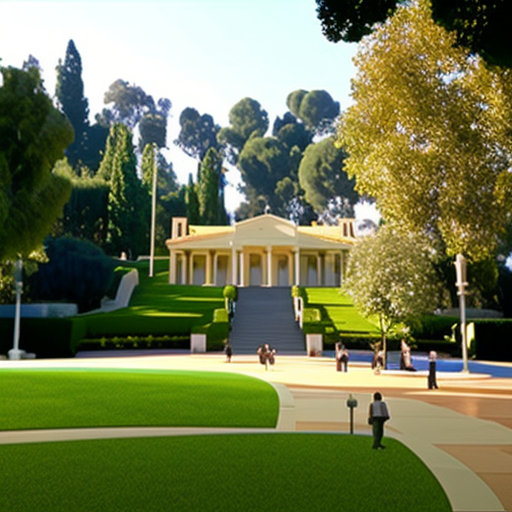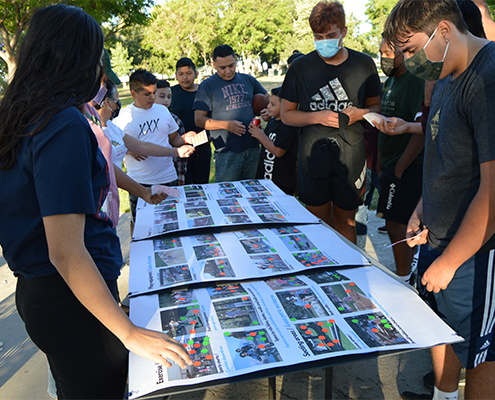
Addressing Park Inequality in Los Angeles County

By Mara Elana Burstein
More than half of Los Angeles County is “park poor,” with 82% of these areas located in communities of color – according to the county’s park needs assessment.
The Link Initiative: A Collaborative Approach
To address this issue, the UCLA Luskin for Innovation (LCI) evaluated a promising initiative, called Link, which stands for Link Advocates, Governments, Families, and Parks.
Collaboration is fundamental to the Link approach. A new report summarizes findings from the study of how experienced nonprofit park building organizations and community-based organizations worked with under-resourced municipal governments and agencies to implement community-driven planning for parks and multibenefit green infrastructure projects in six disadvantaged communities in Los Angeles County.
Key Findings and Benefits of the Link Model
Researchers found that the Link model results in projects – identified and supported by communities – successfully getting funded and built in the communities that most need them. Other findings include that the Link model builds capacity in under-invested communities, navigates bureaucracy, ensures community members have a voice in decision-making, and leverages funding opportunities (such as voter approved Measure A).
“The Link model is a great success,” said Jon Christensten, an LCI affiliated scholar and author of the report. “The priority now is to increase its scale with consistent public support to regularly and creatively fund park acquisitions, renovations, and maintenance in underserved neighborhoods.”
Roadmap and Policy Recommendations
LCI’s report includes a roadmap to develop parks, and also offers lessons learned, metrics for success, and eight policy recommendations to better support the model. Guidance includes specific advice on how to minimize bureaucratic barriers and scale the model to more high- and very-high need communities throughout the county.
Sustainable Development Goals (SDGs)
Quality parks and green spaces are integral to healthy, equitable, and environmentally sustainable communities. To ensure equitable access and benefits in lower-income communities, reliable funding is needed.
Supporting Organizations
This research was made possible with the generous support of First 5 LA, The Rosalinde and Arthur Gilbert Foundation, the California Wellness Foundation, and Resources Legacy Fund.
Accessing the Report
To learn more about the findings, access the report here. For more research on developing equitable parks and green space, visit our Urban Greening webpage.
SDGs, Targets, and Indicators
| SDGs | Targets | Indicators |
|---|---|---|
| SDG 11: Sustainable Cities and Communities | 11.7 By 2030, provide universal access to safe, inclusive and accessible, green and public spaces, in particular for women and children, older persons and persons with disabilities | – Percentage of population with access to safe and inclusive green and public spaces – Percentage of green and public spaces accessible to persons with disabilities |
| SDG 10: Reduced Inequalities | 10.2 By 2030, empower and promote the social, economic and political inclusion of all, irrespective of age, sex, disability, race, ethnicity, origin, religion or economic or other status | – Percentage of disadvantaged communities with access to parks and green infrastructure projects – Percentage of community members involved in decision-making processes |
| SDG 16: Peace, Justice and Strong Institutions | 16.6 Develop effective, accountable and transparent institutions at all levels | – Number of bureaucratic barriers minimized in park development projects |
| SDG 17: Partnerships for the Goals | 17.17 Encourage and promote effective public, public-private and civil society partnerships, building on the experience and resourcing strategies of partnerships | – Number of successful partnerships between nonprofit organizations, community-based organizations, and municipal governments in park planning and development |
1. Which SDGs are addressed or connected to the issues highlighted in the article?
SDG 11: Sustainable Cities and Communities
The article highlights the issue of park poverty in Los Angeles County, where more than half of the county is considered “park poor.” This connects to SDG 11, which aims to make cities and human settlements inclusive, safe, resilient, and sustainable.
SDG 10: Reduced Inequalities
The article mentions that 82% of park-poor areas in Los Angeles County are located in communities of color. This highlights the issue of inequality in access to parks and green spaces, aligning with SDG 10’s goal of reducing inequalities.
SDG 16: Peace, Justice and Strong Institutions
The article discusses how the Link model helps navigate bureaucracy and minimize bureaucratic barriers in park development projects. This relates to SDG 16, which focuses on developing effective, accountable, and transparent institutions at all levels.
SDG 17: Partnerships for the Goals
The article emphasizes the importance of collaboration and partnerships between nonprofit organizations, community-based organizations, and municipal governments in park planning and development. This aligns with SDG 17, which promotes partnerships for achieving sustainable development goals.
2. What specific targets under those SDGs can be identified based on the article’s content?
Target 11.7: By 2030, provide universal access to safe, inclusive and accessible, green and public spaces, in particular for women and children, older persons and persons with disabilities.
The article discusses the need for equitable access to parks and green spaces, especially in lower-income communities. This target aims to ensure universal access to safe and inclusive green and public spaces.
Target 10.2: By 2030, empower and promote the social, economic and political inclusion of all, irrespective of age, sex, disability, race, ethnicity, origin, religion or economic or other status.
The article highlights the importance of community-driven planning for parks and green infrastructure projects, ensuring that community members have a voice in decision-making processes. This target focuses on promoting the inclusion of all individuals, irrespective of their background or status.
Target 16.6: Develop effective, accountable and transparent institutions at all levels.
The article mentions the need to navigate bureaucracy and minimize bureaucratic barriers in park development projects. This target aims to develop institutions that are effective, accountable, and transparent.
Target 17.17: Encourage and promote effective public, public-private and civil society partnerships, building on the experience and resourcing strategies of partnerships.
The article emphasizes the successful partnerships between nonprofit organizations, community-based organizations, and municipal governments in implementing community-driven planning for parks. This target promotes effective partnerships between different sectors to achieve sustainable development goals.
3. Are there any indicators mentioned or implied in the article that can be used to measure progress towards the identified targets?
Yes, the article mentions or implies several indicators that can be used to measure progress towards the identified targets:
- Percentage of population with access to safe and inclusive green and public spaces
- Percentage of green and public spaces accessible to persons with disabilities
- Percentage of disadvantaged communities with access to parks and green infrastructure projects
- Percentage of community members involved in decision-making processes
- Number of bureaucratic barriers minimized in park development projects
- Number of successful partnerships between nonprofit organizations, community-based organizations, and municipal governments in park planning and development
These indicators can be used to track the progress in achieving universal access to safe and inclusive green spaces, promoting social inclusion, minimizing bureaucratic barriers, and fostering effective partnerships.
4. SDGs, Targets, and Indicators
| SDGs | Targets | Indicators |
|---|---|---|
| SDG 11: Sustainable Cities and Communities | 11.7 By 2030, provide universal access to safe, inclusive and accessible, green and public spaces, in particular for women and children, older persons and persons with disabilities | – Percentage of population with access to safe and inclusive green and public spaces – Percentage of green and public spaces accessible to persons with disabilities |
| SDG 10: Reduced Inequalities | 10.2 By 2030, empower and promote the social, economic and political inclusion of all, irrespective of age, sex, disability, race, ethnicity, origin, religion or economic or other status | – Percentage of disadvantaged communities with access to parks and green infrastructure projects – Percentage of community members involved in decision-making Copyright: Dive into this article, curated with care by SDG Investors Inc. Our advanced AI technology searches through vast amounts of data to spotlight how we are all moving forward with the Sustainable Development Goals. While we own the rights to this content, we invite you to share it to help spread knowledge and spark action on the SDGs. Fuente: innovation.luskin.ucla.edu
Join us, as fellow seekers of change, on a transformative journey at https://sdgtalks.ai/welcome, where you can become a member and actively contribute to shaping a brighter future.
|







